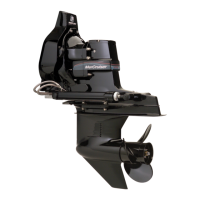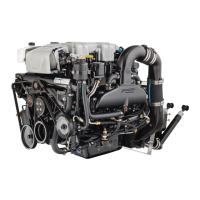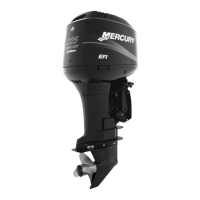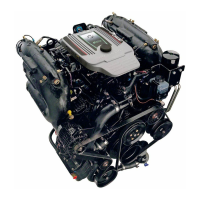Section 4 - Maintenance
90-8M0114081 eng DECEMBER 2015 Page 53
7. Install the seal and cover using the screws and washers. Do not overtighten the cover screws.
a - Screws and washers
b - Cover with glass
c - Strainer
d - Housing
e - Drain plug and sealing washer
f - Seal
8. Open the seacock, if equipped, or remove the plug and reconnect the seawater inlet hose.
9. Upon first starting the engine, check for leaks or air in the system that would indicate an external leak.
Corrosion Protection
General Information
When two or more dissimilar metals are submerged in a conductive solution of saltwater, polluted water, or water with a high
mineral content, a chemical reaction takes place causing electrical current to flow between metals. The electrical current flow
causes the metal that is most chemically active, or anodic, to erode. This erosion is known as galvanic corrosion and, if it is not
controlled, it will eventually cause the need for replacement of power package components exposed to water.
To help control the effects of galvanic corrosion, Mercury Diesel power packages come with several sacrificial anodes and
other corrosion protection devices. For a more comprehensive explanation of corrosion and corrosion protection refer to the
Marine Corrosion Protection Guide.
IMPORTANT: Replace sacrificial anodes if they are eroded 50% or more. Mercury Diesel strongly recommends avoiding the
use of anodes from other manufacturers. Refer to your Mercury Diesel–authorized repair facility for additional information.
Sacrificial Anode
The sacrificial anode in the cooling system must be checked as specified by the maintenance schedule. The anode is located
at the back of the charge air cooler.
a - Sacrificial anode
b - Length of a new anode = 20 mm
(0.79 in.)
c - Back of the charge air cooler
1. Close the seacock.
2. Place a suitable container capable of holding approximately 2–2.5 L (2.1–2.6 US qt) of liquid in a position to capture the
escaping seawater.
3. Remove the sacrificial anode.
4. Inspect the anode. If the anode is less than 10 mm (0.39 in.), it has eroded more than 50% and must be replaced.
a
b
c
d
e
f
12863
